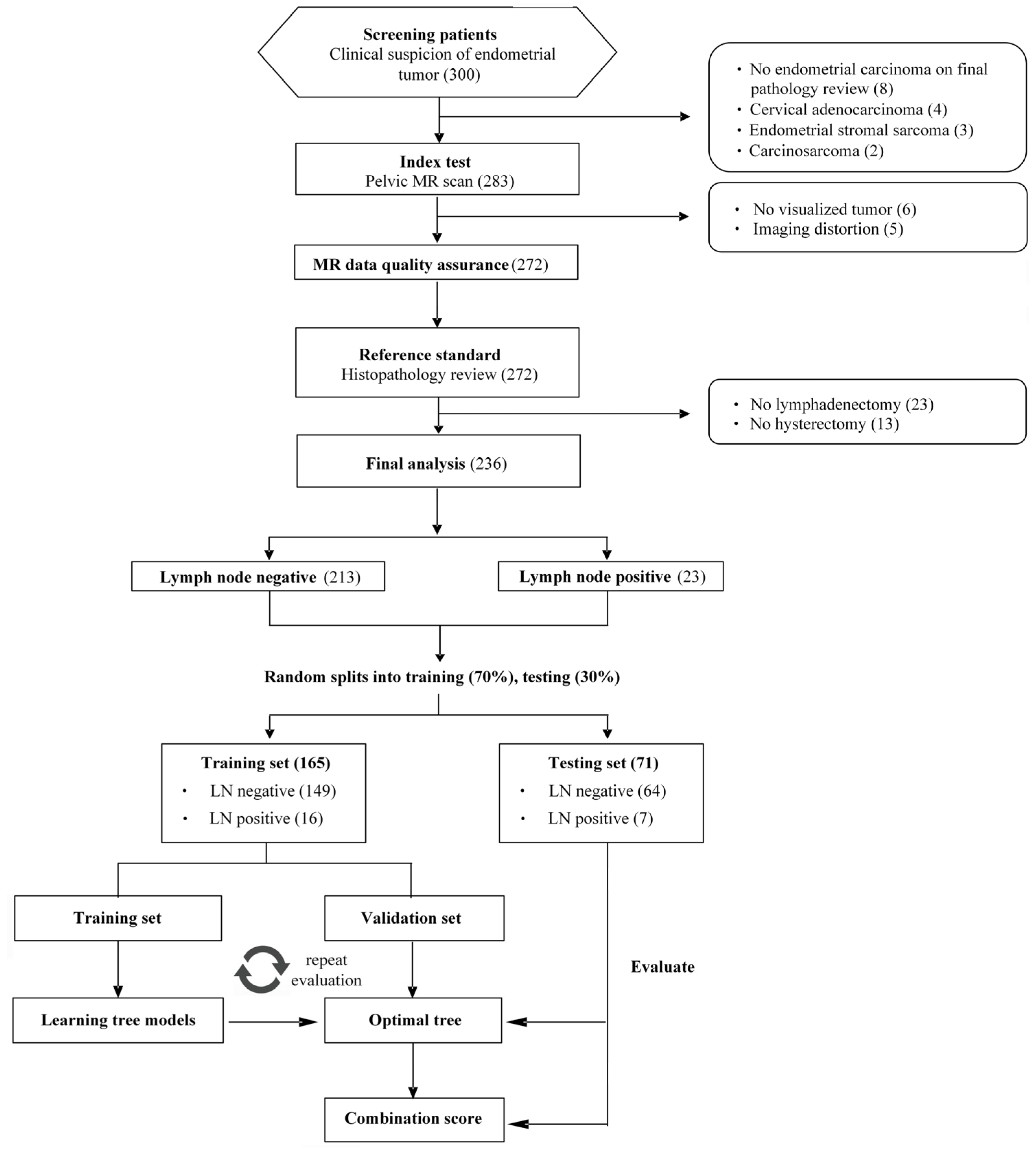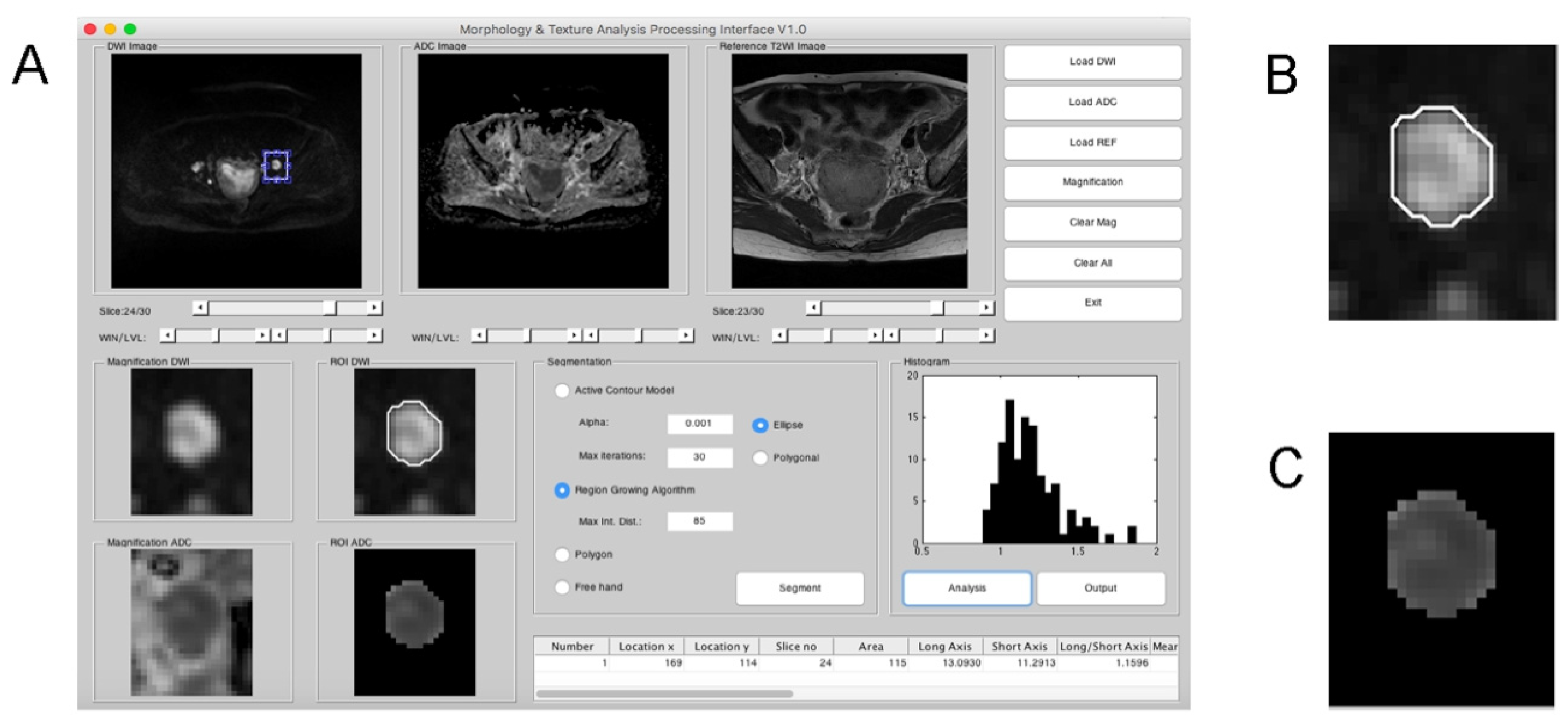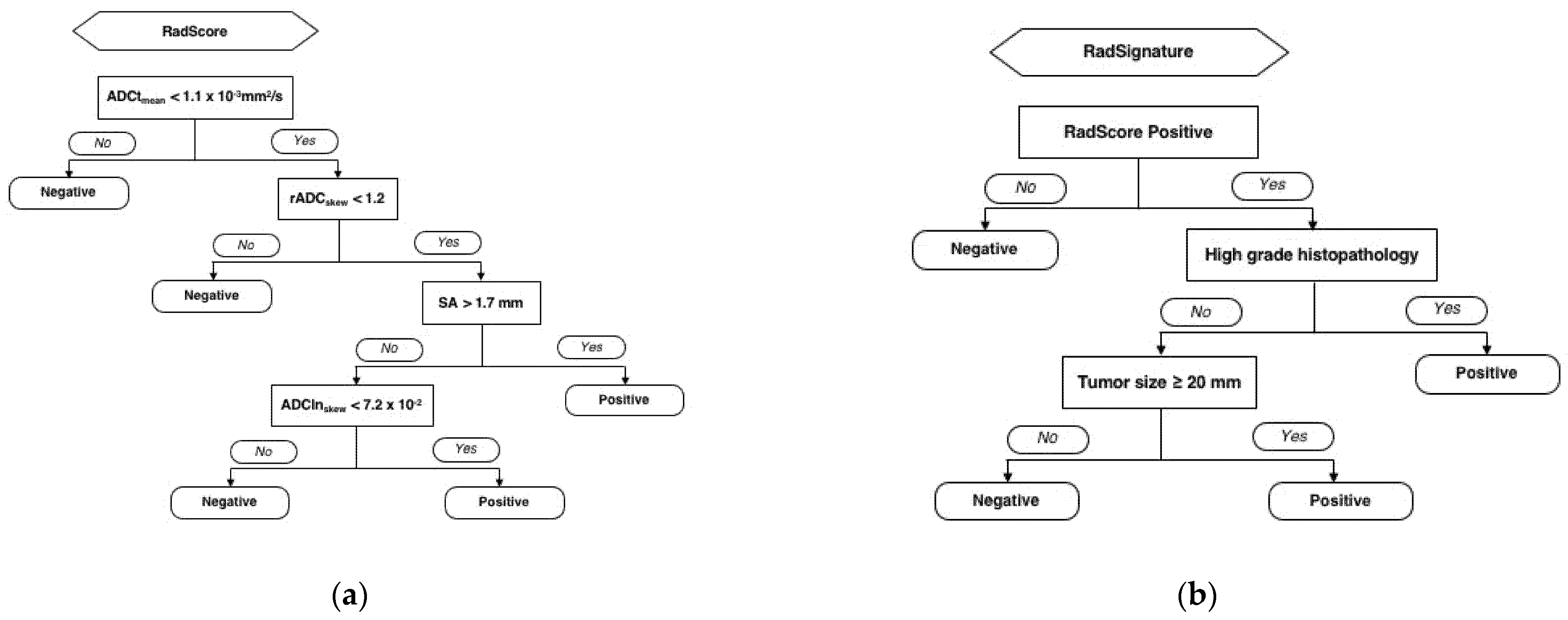Computer-Aided Segmentation and Machine Learning of Integrated Clinical and Diffusion-Weighted Imaging Parameters for Predicting Lymph Node Metastasis in Endometrial Cancer
Abstract
Simple Summary
Abstract
1. Introduction
2. Materials and Methods
2.1. Patients and Imaging Protocol
2.2. Image Processing and Feature Extraction
2.3. Histopathology
2.4. Statistical Analysis
3. Results
3.1. Demographics
3.2. Data Distribution
3.3. Model Comparison and Subgroup Analysis
4. Discussion
5. Conclusions
Author Contributions
Funding
Institutional Review Board Statement
Informed Consent Statement
Data Availability Statement
Acknowledgments
Conflicts of Interest
Appendix A
Appendix A.1. Imaging Protocol
Appendix A.2. Segmentation of Tumors and Lymph Nodes (LNs)
Appendix A.3. Surgical Procedure and Histopathology
Appendix A.4. Statistical Analysis

References
- Lortet-Tieulent, J.; Ferlay, J.; Bray, F.; Jemal, A. International Patterns and Trends in Endometrial Cancer Incidence, 1978–2013. J. Natl. Cancer Inst. 2018, 110, 354–361. [Google Scholar] [CrossRef]
- Creasman, W.T.; Odicino, F.; Maisonneuve, P.; Quinn, M.A.; Beller, U.; Benedet, J.L.; Heintz, A.P.; Ngan, H.Y.; Pecorelli, S. Carcinoma of the corpus uteri. FIGO 26th Annual Report on the Results of Treatment in Gynecological Cancer. Int. J. Gynaecol. Obstet. 2006, 95 (Suppl. S1), S105–S143. [Google Scholar] [CrossRef]
- Kitchener, H.; Swart, A.M.; Qian, Q.; Amos, C.; Parmar, M.K. Efficacy of systematic pelvic lymphadenectomy in endometrial cancer (MRC ASTEC trial): A randomised study. Lancet 2009, 373, 125–136. [Google Scholar] [CrossRef]
- Benedetti Panici, P.; Basile, S.; Maneschi, F.; Alberto Lissoni, A.; Signorelli, M.; Scambia, G.; Angioli, R.; Tateo, S.; Mangili, G.; Katsaros, D.; et al. Systematic pelvic lymphadenectomy vs. no lymphadenectomy in early-stage endometrial carcinoma: Randomized clinical trial. J. Natl. Cancer Inst. 2008, 100, 1707–1716. [Google Scholar] [CrossRef]
- Eggemann, H.; Ignatov, T.; Kaiser, K.; Burger, E.; Costa, S.D.; Ignatov, A. Survival advantage of lymphadenectomy in endometrial cancer. J. Cancer Res. Clin. Oncol. 2016, 142, 1051–1060. [Google Scholar] [CrossRef]
- Kang, S.; Nam, J.H.; Bae, D.S.; Kim, J.W.; Kim, M.H.; Chen, X.; No, J.H.; Lee, J.M.; Kim, J.H.; Watari, H.; et al. Preoperative assessment of lymph node metastasis in endometrial cancer: A Korean Gynecologic Oncology Group study. Cancer 2017, 123, 263–272. [Google Scholar] [CrossRef]
- Reijnen, C.; IntHout, J.; Massuger, L.; Strobbe, F.; Kusters-Vandevelde, H.V.N.; Haldorsen, I.S.; Snijders, M.; Pijnenborg, J.M.A. Diagnostic Accuracy of Clinical Biomarkers for Preoperative Prediction of Lymph Node Metastasis in Endometrial Carcinoma: A Systematic Review and Meta-Analysis. Oncologist 2019, 24, e880–e890. [Google Scholar] [CrossRef]
- Roy, C.; Bierry, G.; Matau, A.; Bazille, G.; Pasquali, R. Value of diffusion-weighted imaging to detect small malignant pelvic lymph nodes at 3 T. Eur. Radiol. 2010, 20, 1803–1811. [Google Scholar] [CrossRef]
- Nakai, G.; Matsuki, M.; Inada, Y.; Tatsugami, F.; Tanikake, M.; Narabayashi, I.; Yamada, T. Detection and evaluation of pelvic lymph nodes in patients with gynecologic malignancies using body diffusion-weighted magnetic resonance imaging. J. Comput. Assist. Tomogr. 2008, 32, 764–768. [Google Scholar] [CrossRef]
- Rechichi, G.; Galimberti, S.; Oriani, M.; Perego, P.; Valsecchi, M.G.; Sironi, S. ADC maps in the prediction of pelvic lymph nodal metastatic regions in endometrial cancer. Eur. Radiol. 2013, 23, 65–74. [Google Scholar] [CrossRef]
- Lin, G.; Ho, K.C.; Wang, J.J.; Ng, K.K.; Wai, Y.Y.; Chen, Y.T.; Chang, C.J.; Ng, S.H.; Lai, C.H.; Yen, T.C. Detection of lymph node metastasis in cervical and uterine cancers by diffusion-weighted magnetic resonance imaging at 3T. J. Magn. Reson. Imaging 2008, 28, 128–135. [Google Scholar] [CrossRef]
- Kwee, T.C.; Takahara, T.; Luijten, P.R.; Nievelstein, R.A. ADC measurements of lymph nodes: Inter- and intra-observer reproducibility study and an overview of the literature. Eur. J. Radiol. 2010, 75, 215–220. [Google Scholar] [CrossRef]
- Taskin, S.; Sukur, Y.E.; Varli, B.; Koyuncu, K.; Seval, M.M.; Ates, C.; Yuksel, S.; Gungor, M.; Ortac, F. Nomogram with potential clinical use to predict lymph node metastasis in endometrial cancer patients diagnosed incidentally by postoperative pathological assessment. Arch. Gynecol. Obstet. 2017, 296, 803–809. [Google Scholar] [CrossRef]
- Bendifallah, S.; Canlorbe, G.; Raimond, E.; Hudry, D.; Coutant, C.; Graesslin, O.; Touboul, C.; Huguet, F.; Cortez, A.; Darai, E.; et al. A clue towards improving the European Society of Medical Oncology risk group classification in apparent early stage endometrial cancer? Impact of lymphovascular space invasion. Br. J. Cancer 2014, 110, 2640–2646. [Google Scholar] [CrossRef] [PubMed]
- Son, J.H.; Kong, T.W.; Kim, S.H.; Paek, J.; Chang, S.J.; Lee, E.J.; Ryu, H.S. Prediction of lymph node metastasis in patients with apparent early endometrial cancer. Obstet. Gynecol. Sci. 2015, 58, 385–390. [Google Scholar] [CrossRef][Green Version]
- Tsikouras, P.; Koukouli, Z.; Bothou, A.; Manav, B.; Iatrakis, G.; Zervoudis, S.; Galazios, G.; Tobias Teichmann, A. Preoperative assessment in endometrial cancer. Is triage for lymphadenectomy possible? Off. J. Balk. Union Oncol. 2017, 22, 34–43. [Google Scholar]
- Lee, J.; Kong, T.W.; Paek, J.; Chang, S.J.; Ryu, H.S. Predicting Model of Lymph Node Metastasis Using Preoperative Tumor Grade, Transvaginal Ultrasound, and Serum CA-125 Level in Patients with Endometrial Cancer. Int. J. Gynecol. Cancer 2016, 26, 1630–1635. [Google Scholar] [CrossRef] [PubMed]
- Zhu, M.; Jia, N.; Huang, F.; Liu, X.; Zhao, Y.; Tao, X.; Jiang, W.; Li, Q.; Feng, W. Whether intermediate-risk stage 1A, grade 1/2, endometrioid endometrial cancer patients with lesions larger than 2 cm warrant lymph node dissection? BMC Cancer 2017, 17, 696. [Google Scholar] [CrossRef] [PubMed]
- Oz, M.; Korkmaz, V.; Meydanli, M.M.; Sari, M.E.; Cuylan, Z.F.; Gungor, T. Is Tumor Size Really Important for Prediction of Lymphatic Dissemination in Grade 1 Endometrial Carcinoma with Superficial Myometrial Invasion? Int. J. Gynecol. Cancer 2017, 27, 1393–1398. [Google Scholar] [CrossRef] [PubMed]
- Vargas, R.; Rauh-Hain, J.A.; Clemmer, J.; Clark, R.M.; Goodman, A.; Growdon, W.B.; Schorge, J.O.; Del Carmen, M.G.; Horowitz, N.S.; Boruta, D.M., 2nd. Tumor size, depth of invasion, and histologic grade as prognostic factors of lymph node involvement in endometrial cancer: A SEER analysis. Gynecol. Oncol. 2014, 133, 216–220. [Google Scholar] [CrossRef]
- Keys, H.M.; Roberts, J.A.; Brunetto, V.L.; Zaino, R.J.; Spirtos, N.M.; Bloss, J.D.; Pearlman, A.; Maiman, M.A.; Bell, J.G.; Gynecologic Oncology, G. A phase III trial of surgery with or without adjunctive external pelvic radiation therapy in intermediate risk endometrial adenocarcinoma: A Gynecologic Oncology Group study. Gynecol. Oncol. 2004, 92, 744–751. [Google Scholar] [CrossRef]
- Pavlakis, K.; Rodolakis, A.; Vagios, S.; Voulgaris, Z.; Messini, I.; Yiannou, P.; Vlachos, A.; Panoskaltsis, T. Identifiable Risk Factors for Lymph Node Metastases in Grade 1 Endometrial Carcinoma. Int. J. Gynecol. Cancer 2017, 27, 1694–1700. [Google Scholar] [CrossRef] [PubMed]
- Therneau, T.; Atkinson, B.; Ripley, B. Rpart: Recursive Partitioning and Regression Trees. R Package Version 4.1–11. 2017. Available online: http://CRAN.R-project.org/package=rpart2017 (accessed on 8 August 2020).
- Colombo, N.; Preti, E.; Landoni, F.; Carinelli, S.; Colombo, A.; Marini, C.; Sessa, C.; Group, E.G.W. Endometrial cancer: ESMO Clinical Practice Guidelines for diagnosis, treatment and follow-up. Ann. Oncol. 2013, 24 (Suppl. S6), vi33–vi38. [Google Scholar] [CrossRef] [PubMed]
- Arian, A.; Easa, A.M.; Arab-Ahmadi, M. Diagnostic value of diffusion-weighted magnetic resonance imaging in discriminating between metastatic and non-metastatic pelvic lymph nodes in endometrial cancer. Acta Radiol. 2020, 61, 1580–1586. [Google Scholar] [CrossRef] [PubMed]
- Rockall, A.G.; Meroni, R.; Sohaib, S.A.; Reynolds, K.; Alexander-Sefre, F.; Shepherd, J.H.; Jacobs, I.; Reznek, R.H. Evaluation of endometrial carcinoma on magnetic resonance imaging. Int. J. Gynecol. Cancer 2007, 17, 188–196. [Google Scholar] [CrossRef]
- Cignini, P.; Vitale, S.G.; Lagana, A.S.; Biondi, A.; La Rosa, V.L.; Cutillo, G. Preoperative work-up for definition of lymph node risk involvement in early stage endometrial cancer: 5-year follow-up. Updates Surg. 2017, 69, 75–82. [Google Scholar] [CrossRef] [PubMed]
- Korkmaz, V.; Meydanli, M.M.; Yalcin, I.; Sari, M.E.; Sahin, H.; Kocaman, E.; Haberal, A.; Dursun, P.; Gungor, T.; Ayhan, A. Comparison of three different risk-stratification models for predicting lymph node involvement in endometrioid endometrial cancer clinically confined to the uterus. J. Gynecol. Oncol. 2017, 28, e78. [Google Scholar] [CrossRef]
- Indira, V.; Vasanthakumari, R.; Jegadeeshwaran, R.; Sugumaran, V. Determination of minimum sample size for fault diagnosis of automobile hydraulic brake system using power analysis. Eng. Sci. Technol. Int. J. 2015, 18, 59–69. [Google Scholar] [CrossRef]




| Variables | RadScore | p-Value | ||
|---|---|---|---|---|
| All | Negative | Positive | ||
| n | 236 (100.0) | 213 (90.3) | 23 (9.7) | |
| Age (year, mean ± SD) | 51.2 ± 11.6 | 50.6 ± 11.8 | 56.2 ± 7.7 | 0.004 * |
| Histology | <0.0001 * | |||
| Non-endometrioid type | 17 (7.2) | 9 (3.8) | 8 (3.4) | |
| Endometrioid type | 219 (92.8) | 204 (86.5) | 15 (6.3) | |
| Grade | <0.0001 * | |||
| 3 | 44 (18.6) | 30 (12.7) | 14 (5.9) | |
| 1 + 2 | 192 (81.4) | 183 (77.6) | 9 (3.8) | |
| Tumor size ≥ 20 mm | 0.009 * | |||
| Presence | 140 (59.3) | 120 (50.8) | 20 (8.5) | |
| Absence | 96 (40.7) | 93 (39.5) | 3 (1.2) | |
| Deep myometrial invasion | <0.0001 * | |||
| Presence | 55 (23.3) | 39 (16.6) | 16 (6.7) | |
| Absence | 181 (76.7) | 174 (73.7) | 7 (3.0) | |
| Low segment involvement | 0.002 * | |||
| Presence | 138 (58.5) | 117 (49.6) | 21 (8.9) | |
| Absence | 98 (41.5) | 96 (40.7) | 2 (0.8) | |
| CA125 (mean ± SD, U/mL) | 52.4 ± 202.4 | 33.2 ± 43.9 | 230.7 ± 618.2 | 0.140 |
| Variables | Lymph Node Metastasis | p-Value | ||
|---|---|---|---|---|
| All | Absent | Present | ||
| n | 236 (100.0) | 151 (64.0) | 85 (36.0) | |
| Age (year, mean ± SD) | 51.2 ± 11.6 | 49.8 ± 11.8 | 53.6 ± 10.8 | 0.017 * |
| Histology | 0.005 * | |||
| Non-endometrioid type | 17 (7.2) | 5 (2.1) | 12 (5.1) | |
| Endometrioid type | 219 (92.8) | 146 (61.9) | 73 (30.9) | |
| Grade | 0.049 * | |||
| 3 | 44 (18.6) | 22 (9.3) | 22 (9.3) | |
| 1 + 2 | 192 (81.4) | 129 (54.7) | 63 (26.7) | |
| Tumor size ≥ 20 mm | 0.002 * | |||
| Presence | 140 (59.3) | 78 (33.1) | 62 (26.2) | |
| Absence | 96 (40.7) | 73 (30.9) | 23 (9.8) | |
| Deep myometrial invasion | <0.0001 * | |||
| Presence | 55 (23.3) | 20 (8.5) | 35 (14.8) | |
| Absence | 181 (76.7) | 131 (55.5) | 50 (21.2) | |
| Low segment involvement | 0.015 * | |||
| Presence | 138 (58.5) | 79 (33.5) | 59 (25.0) | |
| Absence | 98 (41.5) | 72 (30.5) | 26 (11.0) | |
| CA125 (mean ± SD, U/mL) | 52.4 ± 202.4 | 32.4 ± 36.3 | 87.9 ± 332.0 | 0.129 |
| Parameters | n | TP | TN | FP | FN | Sensitivity | Specificity | Accuracy |
|---|---|---|---|---|---|---|---|---|
| Region basis (Training) | ||||||||
| RadSignature | 330 | 22 | 267 | 40 | 1 | 95.7% (78.1–99.9%) | 87.0% (82.7–90.5%) | 87.6% (83.5–90.9%) |
| RadScore | 330 | 22 | 248 | 59 | 1 | 95.7% (78.1–99.9%) | 80.8% (75.9–85.0%) | 81.8% (77.2–85.8%) |
| ADC | 330 | 21 | 91 | 216 | 2 | 91.3% (72.0–98.9%) | 29.6% (24.6–35.1%) * | 33.9% (28.8–39.3%) * |
| SA | 330 | 16 | 213 | 94 | 7 | 69.6% (47.1–86.8%) * | 69.4% (63.9–74.5%) * | 69.4% (64.1–74.3%) * |
| Region basis (Testing) | ||||||||
| RadSignature | 142 | 8 | 114 | 18 | 2 | 80.0% (44.4–97.5%) | 86.4% (79.3–91.7%) | 85.9% (79.1–91.2%) |
| RadScore | 142 | 8 | 106 | 26 | 2 | 80.0% (44.4–97.5%) | 80.3% (72.5–86.7%) | 80.3% (72.8–86.5%) |
| ADC | 142 | 7 | 32 | 100 | 3 | 70.0% (34.8–93.3%) | 24.2% (17.2–32.5%) * | 27.5% (20.3–35.6%) * |
| SA | 142 | 7 | 85 | 47 | 3 | 70.0% (34.8–93.3%) | 64.4% (55.6–72.5%) * | 64.8% (56.3–72.6%) * |
| Patient basis (Training) | ||||||||
| RadSignature | 165 | 15 | 119 | 30 | 1 | 93.8% (69.8–99.8%) | 79.9% (72.5–86.0%) | 81.2% (74.4–86.9%) |
| RadScore | 165 | 15 | 105 | 44 | 1 | 93.8% (69.8–99.8%) | 70.5% (62.5–77.7%) | 72.7% (65.3–79.4%) |
| ADC | 165 | 15 | 25 | 124 | 1 | 93.8% (69.8–99.8%) | 16.8% (11.2–23.8%) * | 24.2% (17.9–31.5%) * |
| SA | 165 | 12 | 80 | 69 | 4 | 75.0% (47.6–92.7%) | 53.7% (45.3–61.9%) * | 55.8% (47.8–63.5%) * |
| Patient basis (Testing) | ||||||||
| RadSignature | 71 | 6 | 50 | 14 | 1 | 85.7% (42.1–99.6%) | 78.1% (66.0–87.5%) | 78.9% (67.6–87.7%) |
| RadScore | 71 | 6 | 44 | 20 | 1 | 85.7% (42.1–99.6%) | 68.8% (55.9–79.8%) | 70.4% (58.4–80.7%) |
| ADC | 71 | 6 | 9 | 55 | 1 | 85.7% (42.1–99.6%) | 14.1% (6.6–25.0%) * | 21.1% (12.3–32.4%) * |
| SA | 71 | 5 | 28 | 36 | 2 | 71.4% (29.0–96.3%) | 43.8% (31.4–56.7%) * | 46.5% (34.5–58.7%) * |
| Variables | AUC Value (95% CI) | p Value |
|---|---|---|
| Region basis | ||
| RadSignature | 0.89 (0.86–0.92) | |
| ADC | 0.56 (0.52–0.61) | |
| SA | 0.69 (0.64–0.73) | |
| RadSignature vs. ADC | <0.0001 † | |
| RadSignature vs. SA | <0.0001 † | |
| ADC vs. SA | 0.0406 | |
| Patient basis | ||
| RadSignature | 0.85 (0.80–0.90) | |
| ADC | 0.54 (0.47–0.60) | |
| SA | 0.62 (0.56–0.69) | |
| RadSignature vs. ADC | <0.0001 † | |
| RadSignature vs. SA | <0.0001 † | |
| ADC vs. SA | 0.1742 |
| Parameters | n | TP | TN | FP | FN | Sensitivity | Specificity | Accuracy |
|---|---|---|---|---|---|---|---|---|
| Low risk | ||||||||
| RadSignature | 165 | 4 | 135 | 25 | 1 | 80.0% (28.4–99.5%) | 84.4% (77.8–89.6%) | 84.2% (77.8–89.4%) |
| RadScore | 165 | 4 | 116 | 44 | 1 | 80.0% (28.4–99.5%) | 72.5% (64.9–79.3%) | 72.7% (65.3–79.4%) |
| ADC | 165 | 5 | 26 | 134 | 0 | 100.0% (47.8–100.0%) | 16.3% (10.9–22.9%) * | 18.8% (13.1–25.6%) * |
| SA | 165 | 1 | 86 | 74 | 4 | 20.0% (0.5–71.6%) * | 53.8% (45.7–61.7%) * | 52.7% (44.8–60.5%) * |
| Intermediate risk | ||||||||
| RadSignature | 36 | 3 | 20 | 12 | 1 | 75.0% (19.4–99.4%) | 62.5% (43.7–78.9%) | 63.9% (46.2–79.2%) |
| RadScore | 36 | 3 | 19 | 13 | 1 | 75.0% (19.4–99.4%) | 59.4% (40.6–76.3%) | 61.1% (43.5–76.9%) |
| ADC | 36 | 4 | 4 | 28 | 0 | 100.0% (39.8–100.0%) | 12.5% (3.5–29.0%) * | 22.2% (10.1–39.2%) * |
| SA | 36 | 2 | 14 | 18 | 2 | 50.0% (6.8–93.2%) | 43.8% (26.4–62.3%) * | 44.4% (27.9–61.9%) * |
| High risk | ||||||||
| RadSignature | 35 | 14 | 14 | 7 | 0 | 100.0% (76.8–100.0%) | 66.7% (43.0–85.4%) | 80.0% (63.1–91.6%) |
| RadScore | 35 | 14 | 14 | 7 | 0 | 100.0% (76.8–100.0%) | 66.7% (43.0–85.4%) | 80.0% (63.1–91.6%) |
| ADC | 35 | 12 | 4 | 17 | 2 | 85.7% (57.2–98.2%) | 19.0% (5.4–41.9%) * | 45.7% (28.8–63.4%) * |
| SA | 35 | 14 | 8 | 13 | 0 | 100.0% (76.8–100.0%) | 38.1% (18.1–61.6%) * | 62.9% (44.9–78.5%) * |
Publisher’s Note: MDPI stays neutral with regard to jurisdictional claims in published maps and institutional affiliations. |
© 2021 by the authors. Licensee MDPI, Basel, Switzerland. This article is an open access article distributed under the terms and conditions of the Creative Commons Attribution (CC BY) license (http://creativecommons.org/licenses/by/4.0/).
Share and Cite
Yang, L.-Y.; Siow, T.Y.; Lin, Y.-C.; Wu, R.-C.; Lu, H.-Y.; Chiang, H.-J.; Ho, C.-Y.; Huang, Y.-T.; Huang, Y.-L.; Pan, Y.-B.; et al. Computer-Aided Segmentation and Machine Learning of Integrated Clinical and Diffusion-Weighted Imaging Parameters for Predicting Lymph Node Metastasis in Endometrial Cancer. Cancers 2021, 13, 1406. https://doi.org/10.3390/cancers13061406
Yang L-Y, Siow TY, Lin Y-C, Wu R-C, Lu H-Y, Chiang H-J, Ho C-Y, Huang Y-T, Huang Y-L, Pan Y-B, et al. Computer-Aided Segmentation and Machine Learning of Integrated Clinical and Diffusion-Weighted Imaging Parameters for Predicting Lymph Node Metastasis in Endometrial Cancer. Cancers. 2021; 13(6):1406. https://doi.org/10.3390/cancers13061406
Chicago/Turabian StyleYang, Lan-Yan, Tiing Yee Siow, Yu-Chun Lin, Ren-Chin Wu, Hsin-Ying Lu, Hsin-Ju Chiang, Chih-Yi Ho, Yu-Ting Huang, Yen-Ling Huang, Yu-Bin Pan, and et al. 2021. "Computer-Aided Segmentation and Machine Learning of Integrated Clinical and Diffusion-Weighted Imaging Parameters for Predicting Lymph Node Metastasis in Endometrial Cancer" Cancers 13, no. 6: 1406. https://doi.org/10.3390/cancers13061406
APA StyleYang, L.-Y., Siow, T. Y., Lin, Y.-C., Wu, R.-C., Lu, H.-Y., Chiang, H.-J., Ho, C.-Y., Huang, Y.-T., Huang, Y.-L., Pan, Y.-B., Chao, A., Lai, C.-H., & Lin, G. (2021). Computer-Aided Segmentation and Machine Learning of Integrated Clinical and Diffusion-Weighted Imaging Parameters for Predicting Lymph Node Metastasis in Endometrial Cancer. Cancers, 13(6), 1406. https://doi.org/10.3390/cancers13061406








